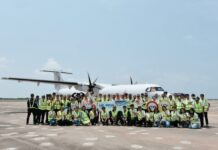

The tumultuous effects of the pandemic in the last two years have upended expectations and caused challenges for long-term planning and analysis. However, the overall aviation and aerospace industries remain resilient and that extends to the air cargo market.
Boeing is forecasting strong demand for air cargo services through 2041 in its 2022 World Air Cargo Forecast (WACF), with traffic doubling and the world’s freighter fleet expanding by more than 60%.
Post-Covid return
Airlines around the world boosted air cargo capacity in response to global transportation needs during the COVID-19 pandemic. With supply chain challenges easing and recovery of long-haul international passenger networks progressing, the industry is now shifting focus to the evolving needs of air cargo demand and networks in the years ahead.
“While the air cargo market is returning to a more normal pace after historic demand in the last two years, structural factors including express network growth, evolving supply chain strategies and new cargo-market entrants are driving sustained freighter demand,” Darren Hulst, Boeing’s Vice President of Commercial Marketing, said. “In the global transportation network, air freighters will continue to be a critical enabler to move high-value goods, in increased volume across expanding markets.”
Read more: WestJet Cargo confirms the launch of four Boeing 737-800 freighters
World’s expanding cargo fleet
The 2022 WACF projects that the world’s cargo fleet will require nearly 2,800 production and converted freighters for growth and replacement through 2041. With cargo traffic doubling over the forecast period, operators will need to switch to more capable, fuel-efficient and sustainable jets like the 777-8 Freighter to meet demand, according to the forecast.
A third of deliveries will consist of new production freighters, while the remaining two-thirds will be freighter conversions, such as the 737-800 Boeing Converted Freighter (BCF), providing carriers with increased flexibility in existing and emerging markets.
With the global freighter fleet set to grow to over 3,600 aircraft in the next two decades, the forecast anticipates that the Asia-Pacific region will be a key area for expansion, taking delivery of nearly 40% of all new and converted freighters.
“Assuming that some of this global disruption does go away sometime in 2023, 2024 could be a very strong year. We have seen the world freighter fleet expand by 300 since 2019. We’re talking an industry that right now only has about 2,250 aircraft in service,” Hulst stated.
Impact of e-commerce
Rapid expansion in e-commerce is expected to boost air cargo growth. Air cargo packages are generally not identified specifically as e-commerce by shippers, and airmail shipments are typically bundled in bags with assorted documents and parcels. However, it is clear that e-commerce is revolutionising customer expectations and air cargo logistics.
Global e-commerce revenues are expected to more than double pre-pandemic levels by 2026, reaching $8.1 trillion—up from $3.4 trillion in 2019, and five times higher than the $1.5 trillion spent in 2015.
While domestic e-commerce business is often supported by large ground networks, growth in cross-border e-commerce, as well as emerging markets without well-established postal and ground networks, will promote an increased role for air cargo.
While e-commerce is a global phenomenon, market size and growth vary by country. China represents the largest e-commerce market in the world, after overtaking the United States in 2013.
In 2021, the Chinese market surpassed $2 trillion, more than double the United States market, which is estimated at $960 billion. The European market was roughly one third the size of China’s market, at $665 billion, in 2021. While currently much smaller, many emerging markets such as India and Brazil are now seeing high growth and rapid network expansion. “A lot of people these days are talking about the rise of e-commerce, especially during the pandemic and it’s undoubtedly a big engine of growth right now,” Hulst added.
Indispensable freighters
Freighters are critical for airlines competing in air cargo markets. While nearly half of the world’s air cargo has historically been carried in the bellies of passenger aeroplanes, freighters are a key component of the customised scheduling and operations flexibility that many air cargo customers need. As a result, airlines with main-deck freighters in their fleets earn 90% of the air cargo industry’s revenue.
While increasingly capable wide-body passenger aeroplanes helped the air cargo industry grow in the decade preceding the pandemic, Boeing expects dedicated freighters to continue to carry at least 50% of the world’s air cargo traffic, even after long-haul passenger networks recover to pre- pandemic levels and beyond.
There are several key reasons for freighter preference in air cargo flows: Most passenger-belly capacity does not serve key cargo trade routes; twin-aisle passenger schedules often do not meet shipper timing needs; freight forwarders prefer palletised capacity, which is not available on single-aisle aircraft; passenger bellies cannot transport hazardous materials and project cargo; two important sectors in air cargo flows, and payload-range considerations on passenger aeroplanes may limit cargo carriage, increasing the risk that cargo will fail to arrive on time.
“Not all that long ago, there were some that debated the value of freighters,” Hulst said. “Many were actively talking about how the industry doesn’t need dedicated freight aeroplanes. But nothing could be further from the truth. Even in the worst of times, more than half of air cargo traffic has been carried on freighters.”
The COVID-19 pandemic highlighted the importance of main-deck freighters in the global air transportation system. With high air cargo yields and greatly reduced long-haul international networks, conditions are favourable for many airlines to use passenger wide-body fleets for cargo-only operations, in order to generate much-needed cash flow and industry capacity.
These “preighters” replaced some of the capacity shortfall, and even (in some cases) generated quarterly profits for carriers, despite minimal passenger operations. While long-haul passenger operations are still recovering, enough passenger capacity has returned to most markets that almost all preighter operations have been discontinued.
In normal times, aeroplanes generate more revenue in passenger service. However, the experience of the past two years has highlighted the value of cargo operations. For airlines looking to diversify risk and operations coming out of the pandemic, that experience has provided an incentive to incorporate cargo operations in their network and fleet planning.
Read more: Atlas Air takes delivery of new Boeing 747-8 freighter
New players
Some shipping companies are exploring a shift to more vertically integrated operational strategies. Historically, freight forwarders were the primary interface between producers and shipping companies. Some shipping companies now aim to compete in the freight-forwarder space by developing their own full-service solutions. For customers, the value propositions here are the elimination of modal uncertainty and the de-risking of service levels. To provide this integrated mobility of goods, some shipping container and logistics companies are acquiring airplanes to provide the promised range of service levels.
This trend suggests some aggregate movement of shipping volumes from sea to air. While the volumes will not likely be large relative to total global trade, even small shifts toward the speed, reliability, and risk mitigation of air could be significant, considering that air cargo now represents only about 1% of global trade volumes.
In addition to growth among established logistics providers, markets are seeing a range of air cargo newcomers, including a spurt of operations growth for smaller general-freight and express airlines. A fleet analysis in the fourth quarter of 2022 revealed roughly 40 more operators than pre-pandemic. In addition, some belly-only operators have added main-deck freighters to their fleets, in efforts to diversify revenues.
Asia leads the way
East Asian markets lead the global air cargo forecast in both volumes and growth rates. Today, the Transpacific and Europe-to-East Asia air cargo flows are the largest. By the end of the forecast period, the intra-East Asia region will become the third largest global market, up from the number-five position in 2021, with 5.7% projected average annual growth.
Driving this shift will be increasing goods production and booming consumer markets. Industrial production, trade, and express-market growth are forecast to propel traffic growth of 5.3% in the domestic China market, the second fastest-growing flow in our 20-year forecast.
The intra-North America and Transatlantic air cargo flows will round out the top five markets by the end of the forecast period, with large markets today but slower growth rates due to the more mature market dynamics of Europe and the United States.
In particular, Hulst cited India as an area to watch, stating how he has “never seen so many people really bullish about the future before.” As companies diversify their businesses, while China will “remain a world manufacturing powerhouse,” the inclusion of redundancy plans will see other Asian nations grow their markets, increasing the need to move cargo to/from them.










